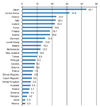Abstract
Figures and Tables
 | Figure 1Number of high-tech imaging devices in Korea. CT, computed tomography; MRI, magnetic resonance imaging; PET, positron emission tomography (From Choi YJ, et al. Development of fee schedule for high-tech medical imaging devices. Seoul: Health Insurance Review Agency; 2012) [6]. |
 | Figure 2Number of computed tomography (CT) per million population in Organization for Economic Cooperation and Development countries (2010, using nearest year when missing) (From Organization for Economic Cooperation and Development. OECD health care resources [Internet]. Paris: Organization for Economic Cooperation and Development) [7]. |
 | Figure 3Number of magnetic resonance imaging (MRI) per million population in OECD countries (2010, using nearest year when missing) (From Organization for Economic Cooperation and Development. OECD health care resources [Internet]. Paris: Organization for Economic Cooperation and Development) [7]. |
 | Figure 4Number of computed tomography (CT) according to the facility type in Korea (From Choi YJ, et al. Development of fee schedule for high-tech medical imaging devices. Seoul: Health Insurance Review Agency; 2012) [6]. |
 | Figure 5Number of magnetic resonance imaging (MRI) according to the facility type in Korea (From Choi YJ, et al. Development of fee schedule for high-tech medical imaging devices. Seoul: Health Insurance Review Agency; 2012) [6]. |
Table 1

Values are presented as number (%).
Tests covered by National Health Insurance were counted.
From Choi YJ, et al. Development of fee schedule for high-tech medical imaging devices. Seoul: Health Insurance Review Agency; 2012 [6].
Table 2

Values are presented as number (%).
Tests covered by National Health Insurance were counted.
From Choi YJ, et al. Development of fee schedule for high-tech medical imaging devices. Seoul: Health Insurance Review Agency; 2012 [6].
Table 3

Values are presented as number (%).
From Han KH, et al. Korean J Hosp Manag 2007;12:31-50, according to the Creative Commons license [8].
a)Angio, computed radiography . digital radiography, mammogram, gamma-camera, computed tomography, magnetic resonance imaging, extracorporeal shock wave lithotripsy, positron emission tomography, linear accelerator, and gamma-knife.
Table 4

Values are presented as number (%).
Units of which production year are unknown were excluded.
From Han KH, et al. Korean J Hosp Manag 2007;12:31-50, according to the Creative Commons license [8].




 PDF
PDF ePub
ePub Citation
Citation Print
Print


 XML Download
XML Download